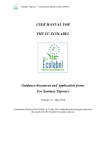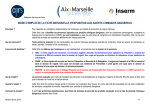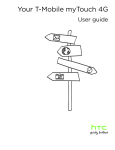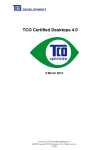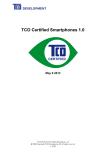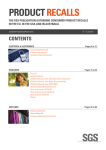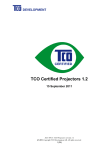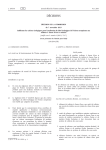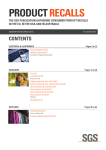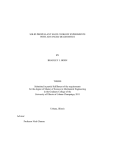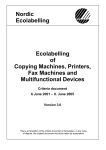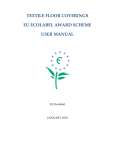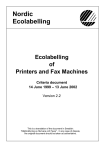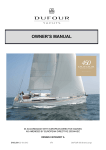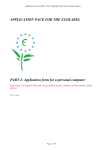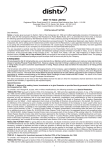Download APPLICATION PACK FOR THE ECOLABEL Application form and
Transcript
APPLICATION PACK FOR THE ECOLABEL Application form and guidance document for personal computers Version 1.0, 2012 Commission Decision of 9 June 2011 on establishing the ecological criteria for the award of the EU Ecolabel for personal computers (Insert name of Competent Body and contact details, including address, telephone and fax numbers and email address) Page 1 of 31 TABLE OF CONTENTS Introduction General Information For which products can applications be made?................................................................ 4 Who can apply for the Eco Label?.....................................................................................4 What does an application/contract cover?..........................................................................4 Choice of analytical laboratory………………………………………………………..…5 Test period and test frequency…………………………………………………………...6 Continuous control the responsibility of the applicant……………………………….….6 Control of compliance criteria…………………………………………………………...6 Application and annual fees………………………………………………………..……7 Transition period for existing eco labelled products…………………………………….7 The application process………………………………………………………………….8 Application Form..............................................................................................................9 Criteria Verification………………………………………………………………….....14 Statement That the Product Meets Eco Label Criteria………………………...….23 Annex I Annex II Page 2 of 31 Introduction The Flower – the European Ecolabel – is the premier European award for products meeting higher environmental standards. The purpose of this User’s Manual is to describe the requirements in form of data and documentation that the applicant has to compile in order to apply for the EU Ecolabel for personal computers. In addition, this manual describes the requirements for demonstrating continued compliance once the label has been granted. The basis for the manual is Commissions Decision of 9 June 2011 of establishing the ecological criteria for the award of the Community eco-label for personal computers (2011/337/EC). General information To obtain the Ecolabel for Personal computers, products must comply with the product group definition and the technical criteria set out in the formal European Commission Decision of 9 June 2011 (2011/337/EU), which appears at on the Commission’s website. The application form contained in this User Manual must be completed and submitted to the Competent Body. The applicant must compile documentation for all relevant criteria for the product(s). Two different types of declarations are often used: from the applicant/manufacturer and declarations from the supplier. All information supplied for the Competent Body is treated as strictly confidential. The Ecolabel criteria aim at promoting reduction of environmental damage or risks related to the use of energy (global warming, acidification, depletion of non-renewable energy sources) by reducing energy consumption, reduction of environmental damage related to the use of natural resources and reduction of environmental damage related to the use of hazardous substances by reducing the use of such substances. The criteria will be valid for 3 years from the date of adoption of Commission decision (2011/337/EC). The application form should be used in conjunction with the separate Guidance Note1, which provides all the necessary information about the scheme, and explains how the Ecolabel application should be assembled and which Competent Body to apply to. (If you intend to apply to a different Competent Body, please use their application form.) Application forms for the European Ecolabel shall be provided in two copies bearing original signatures. The application form will be provided by any of the Competent Bodies responsible for the European Scheme. For any information, please get in contact whit the Ecolabel Helpdesk ([email protected]). 1 http://ec.europa.eu/environment/ecolabel/ecolabelled_products/categories/pdf/apppack_part1.pdf Page 3 of 31 For which products can applications be made? The product group 'personal computers' can apply for the EU Ecolabel. The product group shall comprise devices which have the following characteristics: • • The product group ‘personal computers’ shall comprise: desktop computers, integrated desktop computers, thin clients, displays and keyboards (as a stand alone item). Notebook computers, small-scale servers, workstations, gaming consoles and digital picture frames shall not be considered personal computers for the purpose of this Decision. Who can apply for EU Ecolabel? Manufacturers, importers, services providers, traders and retailers, may submit applications for the Ecolabel. Traders and retailers may submit applications in respect of products placed on the trade market under their own brand names. If a product is being sold in a single Member State the application shall be presented in this Member State. If a product is being sold in the same form in several Member States the application may be presented in any of these Member States. If a product originates from outside the Community the application may be presented in any of the Member States in which the product is to be, or has been, placed on the market. What does an application/contract cover? At application the applicant must report the trade names and identification or reference numbers of the products in question. All chemicals used for the Ecolabelled product must be reported in the application. When the application has been processed and approved by the Competent Body a certificate is sending to the company referring to the company, to the range of products and to the different trade names of the products certified. In the case when there are other demands and other products certified in the same product group an extra certificate is sent. With the certificate a contract specifying the reference of the decision for product group must be signed by the company and by the competent body. In case the contract holder wants to extend his range of products the following conditions apply: Extension with new identification/reference commercial names, which do not affect the criteria, can be done by sending specific information to the Competent Body. In this case a letter of prolongation is sent to the competent body with the new trademark and the name of the product which has been certified before with the same characteristics. After validation of the new environmental labelling, a certificate with the new commercial reference is sent. Extension with new technical characteristics (for example modified product formulation, new product formulations added or other changes with influence on the Ecolabel criteria): An application form must be approved by the Competent Body specifying the relevant changes and the extensions must be approved by the Competent Body prior to use/marketing. If new trade names apply, the Competent Body will forward and updated appendix to the contract specifying the new trade names added. Page 4 of 31 Extension with new suppliers can be done by providing the Competent Body with documentation for the suppliers’ compliance with the criteria. Besides, an updated list of suppliers must be provided. Choice of analytic laboratory In the criteria document, the Assessment and verification requirements say: "Where possible, the testing should be performed by laboratories that meet the general requirements of EN ISO 17025 or equivalent". There is a need for a common practice on how this shall be interpreted, and this document describes a hierarchy of situations and conditions for acceptance of a laboratory. The national competent body or eco-labelling board will consider the applications individually taking into account the following approach and making a decision according to the concrete situation without prejudice to the credibility of the European eco-labelling scheme. (1) Laboratory tests shall be performed by laboratories that are accredited for the specified test method according to ISO 17025 or GLP, where possible. The Competent Bodies accept all accredited laboratories in all Member States in the EU/EEA and in countries that have signed the mutual recognition agreement according to ILAC, the international accreditation organisation. If in the Member State where the applicant submits its dossier or where the company or the concerned production plant or service is based, one or more laboratories are accredited according to ISO 17025 or GLP, applicants shall use such a laboratory, either in that Member State or another. (2) Laboratories with an accreditation for other tests than those required by the criteria can be accepted if they submit a declaration that the tests are done following the same quality management procedures as the tests for which they obtained an accreditation. In case of doubt, the competent body or national board shall inspect the lab that carries out the tests or shall select an accredited auditor who will be charged to do so. (3) If neither point 1 or 2 is possible, applicants should call on a non-accredited independent laboratory certified or approved by a Government Department or other public body in a Member State In case of doubt, the competent body or national board shall inspect the lab that carries out the tests or shall select an accredited auditor who will be charged to do so. (4) If none of points 1 - 3 are possible, applicants may have the tests performed by an independent laboratory that is neither accredited nor approved by authorities according to point 3. Laboratories with a quality management system shall be preferred. A laboratory situated in an organisation holding an ISO 9001- certificate, may be accepted if the scope of the certification includes the laboratory. The competent body or national board shall verify the competence of the laboratory that carries out the tests or shall select an accredited auditor who will be charged to do so. (5) If none of the above mentioned points can be fulfilled, the applicant may have the tests carried out in a company laboratory (that is not accredited ISO 17025 or GLP, as this would be covered by point (1). The competent body or national board shall ensure that the tests are properly carried out or shall select an accredited auditor who will be charged to do so. In this case, the laboratory shall have a quality management system. A laboratory within an organisation holding an ISO 9001- certificate is accepted as being under appropriate quality management, if the scope of the certification includes the laboratory. This option may also be used for continuous monitoring of the production, including discharges and emissions, and for testing fitness for use when no standard test method exists. Page 5 of 31 Test period and test frequency Test results/test reports will be required by the Competent Body upon application. It is the responsibility of the contract holder that the products are in continuous compliance with the Ecolabel criteria. Once the products covered by the Ecolabel application have been awarded the Ecolabel, random tests (e.g. fitness for use) can be realized during the validity period of the Ecolabel by the Competent Body in order to check whether the products still comply with the Ecolabel criteria. Continuous control – the responsibility of the applicant After an Ecolabel has been granted the applicant must keep the dossier up to date. In case where continued tests or measurements are performed/required (e.g. in case of changes of the product formulation or for support of new product claims), the contract holder or the supplier is responsible for keeping a journal of the test results and the associated documentation. This documentation must be available at all times to the Competent Body if considered to be of influence on the continued compliance with the Ecolabel criteria. In case data shows that the product during the validity period no longer complies with the criteria this must be reported to the Competent Body immediately together with a statement for the non-compliance. The Competent Body will in each individual case decide the consequences of the non-compliance (e.g. demand for further testing, suspension of the label etc.). Control of compliance with the criteria The Competent Body may undertake all or any necessary investigations to monitor the ongoing compliance by the contract holder – both with the specific Ecolabel criteria for the product group and the terms of use and provisions of the contract. For this purpose the Competent Body may request any relevant documentation to prove such compliance. The contract holder is obliged to provide this documentation. Furthermore the Competent Body may at any reasonable time and without notice request and be granted access to the premises. Costs [the Competent Bodies are at all times responsible for inserting the correct economic figures applicable for the Member State] Application fee Application fee, first application Application fee, first application, for SME’s and applicants from developing countries 1) Application fee, first application, for micro-enterprises 2) Application fee, renewal 3) Application fee, renewal, for SME’s and applicants from developing countries 1,3) Application fee, renewal, for micro-enterprises 2,3) Fee for extension of a license Amount (2011 figures) 1200 € 600 € 350 € 600 € 300 € 200 € Spent working hours (fixed unit price per hour), max 1200/600/350 € (not exceeding the application fee). Page 6 of 31 1) SME’s (Small and Medium-sized Enterprises): More than 10 but less than 250 employees and a yearly turnover equal to or less than 50 mio. € (according to Commission recommendation 2003/361/EC of May 6, 2003) 2) Micro-enterprise: Less than 10 employees and a yearly turnover equal to or less than 2 mio. € (according to Commission recommendation 2003/361/EC of May 6, 2003) 3) If application for renewal of a license is sent in after the license has expired a normal application fee corresponding to 1200/600/,50 € will apply In addition, if the enterprise is either EMAS or ISO 14001 certified, an additional 20% discount on the application fee is given provided that the requirements to the Ecolabel are incorporated in the certification. Annual Fee Annual fee Annual fee for SME Annual fee for micro-enterprises Amount 1500 € 750 € 350 € Transition period for existing Eco labelled products A transitional period should be allowed for producers whose products have been awarded the Ecolabel for personal computers on the basis of the criteria set out in Decision 2005/341/EC, so that they have sufficient time to adapt their products to comply with the revised criteria and requirements. Producers should also be allowed to submit applications based on the criteria set out in Decision 2005/341/EC or on the criteria set out in this Decision until the lapse of validity of that Decision. The application process When ready to apply the applicant will have to fill in an application form which is found in this User’s Manual. The application form must be send together with the relevant documentation to the Competent Body. After receiving an application the Competent Body examines the documentation material including the possible material sent directly from the suppliers. The Competent Body can ask for further information, if necessary. The case officer at the Competent Body makes a status of any additional documentation required in order to comply with the Ecolabel criteria, if any. This status is forwarded to the applicant who will have to ensure that the relevant documentation is forwarded. After all documentation has been approved the Competent Body may carry out an on-site visit to the applicant and/or his suppliers. The Competent Body judges from case to case whom to visit. When all requirements have been met, the Competent Body notifies the application in the European Commission who registers the contract. When criteria documents are revised, the license holders will have to apply for re-assessment of their license according to the revised criteria. A transition period for adjusting the products and apply for re-assessment will apply. This will be announced by the European Commission. Page 7 of 31 Definitions and descriptions of terms used in this User Manual Computer: A device which performs logical operations and processes data. Computers are composed of, at a minimum: (1) a central processing unit (CPU) to perform A. operations; (2) user input devices such as a keyboard, mouse, digitizer or game controller; and (3) a computer display screen to output information. For the purposes of this specification, computers include both stationary and portable units, including desktop computers, integrated desktop computers, notebook computers, small-scale servers, thin clients and workstations. Although computers must be capable of using input devices and computer displays, as noted in numbers 2 and 3 above, computer systems do not need to include these devices on shipment to meet this definition (Reference: Commission Decision 2009/489/EC). Components Computer Display: A display screen and its associated electronics encased in a single housing, or within the computer housing (e.g., notebook or integrated desktop computer), that is capable of displaying output information from a computer via one or more inputs, such as a VGA, DVI, Display Port, and/or IEEE 1394. Examples of computer display technologies are the cathode-ray tube (CRT) and liquid crystal display (LCD) (Reference: Commission Decision 2009/489/EC). Discrete Graphics Processing Unit (GPU): A graphics processor with a local memory controller interface and a local, graphics-specific memory (Reference: Commission Decision 2009/489/EC). External Power Supply: A component contained in a separate physical enclosure external to the computer casing and designed to convert line voltage AC input from the mains to lower DC voltage(s) for the purpose of powering the computer. An external power supply must connect to the computer via a removable or hard-wired male/female electrical connection, cable, cord or other wiring (Reference: Commission Decision 2009/489/EC). Internal Power Supply: A component internal to the computer casing and designed to convert AC voltage from the mains to DC voltage(s) for the purpose of powering the computer components. For the purposes of this specification, an internal power supply must be contained within the computer casing but be separate from the main computer board. The power supply must connect to the mains through a single cable with no intermediate circuitry between the power supply and the mains power. In addition, all power connections from the power supply to the computer components, with the exception of a DC connection to a computer display in an Integrated Desktop Computer, must be internal to the computer casing (i.e., no external cables running from the power supply to the computer or individual components). Internal DC-to-DC converters used to convert a single DC voltage from an external power supply into multiple voltages for use by the computer are not considered internal power supplies (Reference: Commission Decision 2009/489/EC). Computer Types Desktop Computer: A computer where the main unit is intended to be located in a permanent location, often on a desk or on the floor. Desktops are not designed for portability and utilise an external computer display, keyboard, and mouse. Desktops are designed for a broad range of home and office applications (Reference: Commission Decision 2009/489/EC). Integrated Desktop Computer: A desktop system in which the computer and computer display function as a single unit which receives its AC power through a single cable. Integrated desktop computers come in one of two possible forms: (1) a system where the computer display and computer Page 8 of 31 are physically combined into a single unit; or (2) a system packaged as a single system where the computer display is separate but is connected to the main chassis by a DC power cord and both the computer and computer display are powered from a single power supply. As a subset of desktop computers, integrated desktop computers are typically designed to provide similar functionality as desktop systems (Reference: Commission Decision 2009/489/EC) . Thin Client: An independently-powered computer that relies on a connection to remote computing resources to obtain primary functionality. Main computing (e.g., programme execution, data storage, interaction with other Internet resources, etc.) takes place using the remote computing resources. Thin Clients covered by this specification are limited to devices with no rotational storage media integral to the computer. The main unit of a Thin Client covered by this specification must be intended for location in a permanent location (e.g. on a desk) and not for portability (Reference: Commission Decision 2009/489/EC). Notebook Computer: A computer designed specifically for portability and to be operated for extended periods of time either with or without a direct connection to an AC power source. Notebooks must utilise an integrated computer display and be capable of operation off an integrated battery or other portable power source. In addition, most notebooks use an external power supply and have an integrated keyboard and pointing device. Notebook computers are typically designed to provide similar functionality to desktops, including operation of software similar in functionality as that used in desktops (Reference: Commission Decision 2009/489/EC). Operational Modes Off Mode: The power consumption level in the lowest power mode which cannot be switched off (influenced) by the user and that may persist for an indefinite time when the appliance is connected to the main electricity supply and used in accordance with the manufacturer’s instructions. For systems where ACPI standards are applicable, the Off Mode correlates to ACPI System Level S5 state (Reference: Commission Decision 2009/489/EC). Sleep Mode: A low power state that the computer is capable of entering automatically after a period of inactivity or by manual selection. A computer with sleep capability can quickly ‘awake’ in response to network connections or user interface devices with a latency of ≤ 5 seconds from initiation of wake event to the system becoming fully usable, including rendering of display. For systems where ACPI standards are applicable, the Sleep mode most commonly correlates to ACPI System Level S3 (suspend to RAM) state (Reference: Commission Decision 2009/489/EC). Idle State: The state in which the operating system and other software have completed loading, a user profile has been created, the machine is not asleep, and activity is limited to those basic applications that the system starts by default (Reference: Commission Decision 2009/489/EC). Active State: The state in which the computer is carrying out useful work in response to (a) prior or concurrent user input or (b) prior or concurrent instruction over the network. This state includes active processing, seeking data from storage, memory, or cache, including idle state time while awaiting further user input and before entering low power modes (Reference: Commission Decision 2009/489/EC). Typical Energy Consumption (TEC): A method of testing and comparing the energy performance of computers, which focuses on the typical electricity consumed by a product while in normal operation during a representative period of time. For Desktops and Notebooks, the key criterion of the TEC approach is a value for typical annual electricity use, measured in kilowatt-hours (kWh), using Page 9 of 31 measurements of average operational mode power levels scaled by an assumed typical usage model (duty cycle). For Workstations, requirements are based on a TEC power value calculated from operational mode power levels, maximum power, and an assumed duty cycle (Reference: Commission Decision 2009/489/EC). Networking and Power Management Network Interface: The components (hardware and software) whose primary function is to make the computer capable of communicating over one or more network technologies. Examples of Network Interfaces are IEEE 802,3 (Ethernet) and IEEE 802,11 (Wi-Fi) (Reference: Commission Decision 2009/489/EC). Wake Event: A user, scheduled, or external event or stimulus that causes the computer to transition from Sleep or Off to active mode of operation. Examples of wake events include, but are not limited to: movement of the mouse, keyboard activity, controller input, real-time clock event, or a button press on the chassis, and in the case of external events, stimulus conveyed via a remote control, network, modem, etc. (Reference: Commission Decision 2009/489/EC). Wake On LAN (WOL): Functionality which allows a computer to wake from Sleep or Off when directed by a network request via Ethernet (Reference: Commission Decision 2009/489/EC). Full Network Connectivity: The ability of the computer to maintain network presence while in sleep mode and intelligently wake when further processing is required (including occasional processing required to maintain network presence). Maintaining network presence may include obtaining and/or defending an assigned interface or network address, responding to requests from other nodes on the network, or maintaining existing network connections, all while in the sleep state. In this fashion, presence of the computer, its network services and applications, is maintained even though the computer is in sleep mode. From the vantage point of the network, a sleeping computer with full network connectivity is functionally equivalent to an idle computer with respect to common applications and usage models. Full network connectivity in sleep is not limited to a specific set of protocols but can cover applications installed after initial installation (Reference: Commission Decision 2009/489/EC). Page 10 of 31 Application for the EU Ecolabel for Personal Computers The Guidance Note2 describes the Eco label application process and the process of assessment to ensure that the product complies with the criteria. Compliance is shown by a mixture of tests and applicant’s declarations, as indicated in Section 2 of this Form. Applicants should complete Sections 1 and 2 of this Application Form (in black, either typescript or manuscript) and submit two signed paper copies - not e-mails - to the Competent Body at the address on the cover of this Form. Applicants should also provide a Dossier of laboratory test reports, sign it, and send this in duplicate to the Competent Body, and keep an up-to-date copy on their premises to show continuing compliance with the criteria. If possible, the Dossier should include an illustration of how applicants intend to use the Eco label on the product and packaging, so that the Competent Body can satisfy itself that the label will be properly used - alternatively, you may prefer to clear the design with us once the licence has been awarded. Section 1 – details of applicant and product Please complete in black, and submit two paper copies (not by e-mail) to the Competent Body For official use A. The Applicant Full name of applicant company: Address (this should be the address for correspondence about the application, and the address to which invoices for fees should be sent – if these addresses are not the same, please give both: if you want us to use a different address in the contract – such as your company’s head office – please give that too): 2 http://ec.europa.eu/environment/ecolabel/ecolabelled_products/categories/pdf/apppack_part1.pdf Page 11 of 31 Contact name, and function: Tel no, and fax no: E-mail: Website: In what capacity are you applying for the Eco label? (manufacturer, importer, service provider, trader or retailer) B. The Product Registered trade name(s) of product or product range, and any trademarks: Model names (or internal reference numbers): Please describe the type of product [including the category within the product group if relevant – i.e. system unit, screen or keyboard] If you are applying for the label for a range of products, please give details of the range: Please summarise the main characteristics and composition: Name and address of manufacturing site (if different from correspondence address above): Is this product manufactured in the same form in other countries? If Page 12 of 31 so, please give addresses of all manufacturing sites: If the product is made outside the EU, please confirm that it has been or will be placed on the market in the EU country to which this application is being made, as this is a condition of applying: Other EU countries in which this product is sold (if sold under different names, please give names): Approximate estimate of annual number of articles produced (as sold in stores – so if normally sold in packs consisting of several items, the pack is one article) If available: approximate estimated volume of annual sales, excluding VAT, in the European Economic Area (i.e. the European Community plus Norway, Iceland and Liechtenstein) of the product at ex-factory prices in [insert relevant currency] (i.e. before transport to the purchaser’s premises or there is a wholesaler’s or retailer’s profit – so excluding the cost of carriage, carriage insurance, and settlement discounts, but including any bulk discount (which is where the customer is offered a percentage reduction in the total price when ordering large quantities of goods): C. This Application Is this the first application for the EU Eco label for this product? (if not, when and where was the first application made, and with what outcome?) If so, how did you first hear about the label? Page 13 of 31 Is this an application to add a new product (that is, with a technical formulation not covered by an existing Eco label that you hold) to a licence for a product range already covered by an Eco label? (if so, please give details of the existing Eco label) Please name any other environmental labelling schemes under which the product has already been registered, such as the Nordic Swan: Please give the name and address of the test centre you have used (for criteria where independent validation is required): Does this test centre meet the general requirements of standard EN ISO 17025? The Competent Body will invoice applicants for a non-returnable application fee on receipt of the application and will apply all relevant reductions. If the application is successful, the Competent Body will invoice the licensee for an annual fee, as explained in the Guidance Note3. 1. Do you wish to claim a fee reduction as an SME? If so, does your company employ fewer than 250 people and have an annual turnover not exceeding 50 million euro, and / or an annual balance sheet total not exceeding 43 million euro? (these are the qualifying criteria) 2. Do you wish to claim a fee reduction for EMAS registration or ISO certification? If so, please provide proof of status. 3. Where the product uses components for which an Eco label fee has already been paid, the annual fee will be based on the annual sales of the products after deduction of the cost value of the components. Do you wish to claim a reduction on these grounds? Please provide details if relevant. 3 http://ec.europa.eu/environment/ecolabel/ecolabelled_products/categories/pdf/apppack_part1.pdf Page 14 of 31 D. Applicant’s undertaking regarding use of the European Eco label (all applicants must sign and date this undertaking) As the applicant for an EU Eco label, I hereby declare that: • I understand and accept the provisions of Regulation EC No 66 / 2010 on the EU Eco label scheme, and in particular Article 2, which states that the Eco label may not be awarded to goods manufactured by processes which are likely to significantly harm man and / or the environment, or which in their normal application could be harmful to the consumer; • I understand and accept the standard assessment and contract procedures proposed by the Eco labelling Competent Body, and accept its terms during the duration of the contract; • I undertake to ensure that the product complies with the Eco label criteria at all times and to notify the Eco labelling Competent Body immediately of any significant modification to it or to the production processes; • I take responsibility for the correct and proper use of the EU Eco label. Signed: Name in capitals: Position in company: Date: Page 15 of 31 Section 2 – Criteria verification Please complete or type in black and submit in duplicate as a paper copy (not by e-mail) to the Competent Body. Using the spaces in the following tables, please indicate if the product meets each criterion, and confirm where required that a report or other information (as specified) is enclosed showing that the product complies with the criterion. This is a summary of those criteria that require test reports, and those for which an applicant’s declaration is acceptable: Display Criterion 1 – Energy Savings a) Computer b) Display Criterion 2-Power Management Criterion 3-Internal power supplies Criterion 4 – Mercury in fluorescent lamps Criterion 5- Hazardous Substances and mixtures Criterion 6 – Substances Criterion 7 – Plastic parts Criterion 8 – Noise Criterion 9 – Recycled content Criterion 10 – User Instructions Criterion 11 – User reparability Criterion 12 – Design for disassembly Criterion 13 – Lifetime extension Criterion 14 – Packaging Keyboard Personal Computer X X X X X X X X X X X X X X X X X X X X X X X X X X X X X X X X X The specific assessment and verification requirements are indicated within each criterion. Where the applicant is required to provide declarations, documentation, analyses, test reports, or other evidence to show compliance with the criteria, it is understood that these may originate from the applicant and/or his supplier(s) and/or their supplier(s), etc, as appropriate. Supporting documentation such as test reports must be collated in the Dossier accompanying the application. Where appropriate, test methods other than those indicated for each criterion may be used if their equivalence is accepted by the Competent Body assessing the application. Where no specific requirements about the test method are stated, the Competent Body expects applicants to make what they regard as reasonable tests, and to keep the reports on these tests on the Dossier in case they are required. In cases of doubt, applicants are advised to check with their chosen test centre that it is content with the test method used. Page 16 of 31 Where appropriate, Competent Bodies may require supporting documentation and may carry out independent verifications. Criterion 1: Energy Savings Requirement Yes No (a) Energy savings for desktop computers and thin clients The energy efficiency performance of desktop computers shall exceed the appropriate category energy efficiency requirements set out in the Agreement as amended by ENERGY STAR v5.0 by at least the following: category A : category B : category C : category D: 40%, 25%, 25%, 30%. Capability adjustments allowed under the Agreement as amended by ENERGY STAR v5.0 may be applied at the same level, except in the case of Discrete Graphics Processing Units (GPUs) where no additional allowance shall be given. (b) Energy savings for computer display (i) The computer display’s energy efficiency performance in active mode shall exceed the energy efficiency requirements set out in Energy Star v5.0 by at least 30 %; (ii) computer display sleep mode power must not exceed 1 W; (iii) computer displays shall have an energy consumption in on-mode of ≤ 100 W measured when set to maximum brightness; (iv) computer monitor off mode power shall not exceed 0,5 W. A signed declaration that their product complies with these requirements is provided. Desktop computer categories for Total Energy Consumption criteria as defined in Commission Decision 2009/489/EC: For the purposes of determining TEC levels, desktops must qualify under Categories A, B, C and D as defined below: (a) Category A: All desktop computers that do not meet the definition of Category B, Category C or Category D below will be considered under Category A for ENERGY STAR qualification. (b) Category B: To qualify under Category B, desktop must have: — equal to 2 Physical Cores; and Greater than or equal to gigabytes (GB) of System Memory. (c) Category C: To qualify under Category C, desktop must have: — Greater than 2 physical cores. Page 17 of 31 In addition to the requirement above, models qualifying under Category C must be configured with a minimum of 1 of the following 2 characteristics: — Greater than or equal to 2 gigabytes (GB) of system memory, and/or — a discrete GPU. (d) Category D: To qualify under Category D, desktops must have: — Greater than or equal to 4 Physical Cores. In addition to the requirement above, models qualifying under Category D must be configured with a minimum of 1 of the following 2 characteristics: — Greater than or equal to 4 gigabytes (GB) of System Memory; and/or — A Discrete GPU with a Frame Buffer Width greater than 128-bit. Further information on calculations for energy efficiency performance for desktop computers is displayed in Annex I and Annex II. Criterion 2: Power Management Requirement Yes No The computer shall comply with power management requirements As defined in ENERGY STAR v5.0 except for display sleep requirement. as follows: a) Power Management Requirements Personal computers shall be shipped with the power management system enabled at the time of delivery to the customers. Power management settings shall be: (i) 10 minutes to screen off (display sleep); (ii) 30 minutes to computer sleep (system level S3, suspended to RAM) (except for thin clients) (b) Network requirements for power management (i) Personal computers with Ethernet capability shall have the ability to enable and disable wake on LAN (WOL) for sleep mode. (c) Network requirements for power management (applies to personal computers shipped through enterprise channels only) (i) Personal computers with Ethernet capability must meet one of the following requirements4: — be shipped with wake on LAN enabled from the sleep mode when operating on AC power, or — provide control to enable WOL that is sufficiently accessible from both the client operating system user interface and over the network if 4 Thin clients – only applies if software updates from the centrally managed network are conducted while the unit is in sleep or off mode. Thin clients whose standard framework for upgrading software does not require off-hours scheduling exempt from the requirement. Page 18 of 31 computer is shipped to enterprise without WOL enabled. (ii) Personal computers with Ethernet capability shall be capable of both remote (via network) and scheduled wake events from sleep mode (e.g. real time clock). Manufacturers shall ensure, where the manufacturer has control (i.e. configured through hardware settings rather than software settings), that these settings can be managed centrally, as the client wishes, with tools provided by the manufacturer. A signed declaration that their product has been shipped in accordance with these requirements is provided. Criterion 3: Internal power supplies Requirement Yes Internal power supplies shall meet at least the energy requirements for internal power supplies set out by Energy Star v5.0 A signed declaration is provided to the competent body that the product meets this criterion. No Note: Energy Star v5.0 Power Supply Efficiency Requirements for computers using an Internal Power Supply – 85 % minimum efficiency at 50 % of rated output and 82 % minimum efficiency at 20 % and 100 % of rated output, with Power Factor ≥ 0.9 at 100% of rated output (Reference: Energy Star v5.0, p.5) Criterion 4: Mercury in fluorescent lamps Requirement Yes Mercury or its compounds shall not intentionally be added to the backlights of the computer display. The Applicant shall declare to the competent body that the backlights of the computer display do not contain more than 0,1 mg mercury or its compounds per lamp. The applicant shall also provide a brief descriptions of the lighting system used. No Criterion 5: Hazardous substances and mixtures Requirement Yes In accordance with Article 6(6) of Regulation (EC) No 66/2010 the product or any part of it shall not contain substances referred to in Article 57 of Regulation (EC) No 1907/2006 nor substances or mixtures meeting the criteria for classification in the following hazard classes or categories in accordance with Regulation (EC) No 1272/2008 of the European Parliament and of the Council. Page 19 of 31 No List of hazard statements and risk phrases: Hazard Statement* Risk Phrase** H300 Fatal if swallowed R28 H301 Toxic if swallowed R25 H304 May be fatal if swallowed and enters airways R65 H310 Fatal in contact with skin R27 H311 Toxic in contact with skin R24 H330 Fatal if inhaled R23/26 H331 Toxic if inhaled R23 H340 May cause genetic defects R46 H341 Suspected of causing genetic defects R68 H350 May cause cancer R45 H350i May cause cancer by inhalation R49 H351 Suspected of causing cancer R40 H360F May damage fertility R60 H360D May damage the unborn child R61 H360FD May damage fertility. May damage the unborn child R60/61/60-61 H360Fd May damage fertility. Suspected of damaging the unborn child R60/63 H360Df May damage the unborn child. Suspected of damaging fertility R61/62 H361f Suspected of damaging fertility R62 H361d Suspected of damaging the unborn child R63 H361fd Suspected of damaging fertility. Suspected of damaging the unborn child R62-63 H362 May cause harm to breast fed children R64 H370 Causes damage to organs R68/20/21/22 H371 May cause damage to organs R48/25/24/23 H372 Causes damage to organs through prolonged or repeated exposure R48/20/21/22 H400 Very toxic to aquatic life R50 H410 Very toxic to aquatic life with long-lasting effects R50-53 H411 Toxic to aquatic life with long-lasting effects R51-53 H412 Harmful to aquatic life with long-lasting effects R52-53 H413 May cause long-lasting effects to aquatic life R53 Page 20 of 31 EUH059 Hazardous to the ozone layer R59 EUH029 Contact with water liberates toxic gas R29 EUH031 Contact with acids liberates toxic gas R31 EUH032 Contact with acids liberates very toxic gas R32 EUH070 Toxic by eye contact R39-41 *As provided for in Regulation (EC) No 1272/2008. **As provided for in Council Directive 67/548/EEC (OJ 196, 16.8.1967, p. 1). The use of substances or mixtures which change their properties upon processing (e.g. become no longer bio available, undergo chemical modification) so that the identified hazard no longer applies is exempted from the above requirement. Concentration limits for substances or mixtures meeting the criteria for classification in the hazard classes or categories listed in the table above, and for substances meeting the criteria of Article 57(a), (b) or (c) of Regulation (EC) No 1907/2006, shall not exceed the generic or specific concentration limits determined in accordance with Article 10 of Regulation (EC) No 1272/2008. Where specific concentration limits are determined, they should prevail over the generic ones. Concentration limits for substances meeting criteria of Article 57(d), (e) or (f) of Regulation (EC) No 1907/2006 shall not exceed 0,1 % weight by weight. The following substances/uses of substances are specifically derogated from this requirement: • • Homogenous parts* with weight below 10 g – all hazard statements and risk phrases listed above Nickel in stainless steel A certificate signed by the appliance manufacturer declaring compliance with these requirements is provided. A declaration of compliance signed by the plastic and flame retardant suppliers is provided. Copies of relevant safety data sheets in accordance with Annex II to Regulation (EC) No 1907/2006 for substances or mixtures are provided. Concentration limits shall be specified in the safety data sheets in accordance with Article 31 of Regulation (EC) No 1907/2006 for substances and mixtures. *Note: ‘homogeneous part’ means one material of uniform composition throughout or a material, consisting of a combination of materials, that cannot be disjointed or separated into different Page 21 of 31 materials by mechanical actions such as unscrewing, cutting, crushing, grinding and abrasive processes (European Commission Directive 2011/65/EU, Article 3). Criterion 6: Substances listed in accordance with Article 59(1) of Regulation (EC) No 1907/2006 No derogation from the exclusion in Article 6(6) may be given concerning substances identified as substances of very high concern and included in the list foreseen in Article 59 of Regulation (EC) No 1907/2006, present in mixtures, in an article or in any homogenous part of a complex article in concentrations higher than 0,1 %. Specific concentration limits determined in accordance with Article 10 of Regulation (EC) No 1272/2008 shall apply in case it is lower than 0,1 %. The "harmonised" Specific Concentration Limits (SCL) determined in accordance with Article 10 of Regulation (EC) No 1272/2008 are the ones listed in annex VI of this regulation (available at: http://ec.europa.eu/enterprise/sectors/chemicals/documents/classification/index_en.htm). In addition, Article 10 of of Regulation (EC) No 1272/2008 gives the possibility to supplier to determine, when not available in Annex VI, their own SCL, called "non harmonised" SCL. The ECHA (European Chemical Agency) will soon s make publicly available all "harmonised" and "non harmonised" classification and their corresponding SCL. Assessment and verification: the list of substances identified as substances of very high concern and included in the candidate list in accordance with Article 59 of Regulation (EC) No 1907/2006 can be found here: http://echa.europa.eu/chem_data/authorisation_process/candidate_list_table_en.asp Reference to the list shall be made on the date of application. The applicant shall provide a declaration of compliance with this criterion, together with related documentation, such as declarations of compliance signed by the suppliers of substances and copies of relevant Safety Data Sheets in accordance with Annex II to Regulation (EC) No 1907/2006 for substances or mixtures. Concentration limits shall be specified in the Safety Data Sheets in accordance with Article 31 of Regulation (EC) No 1907/2006 for substances and mixtures. Criterion 7: Plastic parts Requirement Yes If any plasticizer substance in the manufacturing process is applied, it must comply with the requirements on hazardous substances set out in Criteria 5 and 6 Additionally, DNOP (di-n-octyl phthalate), DINP (di-isononyl phthalate) and DIDP (di-isodecyl phthalate) shall not intentionally be added to the product. Plastic parts shall not contain a chlorine content greater than 50% by weight. Page 22 of 31 No Only biocidal products containing biocidal active substances included in Annex IA to Directive 98/8/EC of the European Parliament and of the Council5, and authorized for use in computers, shall be allowed for use. A certificate signed by the manufacturer declaring compliance with these requirements. A declaration of compliance signed by the plastic suppliers and copies of relevant safety data sheets about materials and substances. All biocides used are clearly indicated. Criterion 8: Noise Requirement Yes The ‘Declared A-weighted Sound Power Level’ (re l pW) of the personal computer, according to paragraph 3.2.5 of ISO 9296, shall not exceed: No — 40 dB (A) in the idle operating mode — 45 dB (A) when accessing a hard-disk drive A report, certifying that the levels of noise emissions have been measured in accordance with ISO 7779 and declared in accordance with ISO 9296 is provided. The report shall state the measured levels of noise emissions in both the idle operating mode and when accessing a disk drive, which shall be declared in accordance with paragraph 3.2.5 of ISO 9296. Criterion 9: Recycled Content Requirement The external plastic case of the system unit, monitor and keyboard shall have a recycled content of not less than 10% by mass. Yes No Requirement Yes The personal computer shall be sold with relevant user information that provides advice on its proper environmental use. The information shall be located in a single, easy-to-find place in the user instructions as well as on the manufacturer’s website. The information shall include in particular: No A signed declaration that their product complies with these requirements, including a statement of the percentage recycled content is provided. Criterion 10: User Instructions 5 OJ L 123, 24.4.1998, p. 1 Page 23 of 31 (a) Energy consumption: TEC value in accordance with ENERGY STAR v5.0, as well as the maximum power demand in each operating mode. In addition, instructions must be provided on how to use the devices energy-saving mode. (b) Information that energy efficiency cuts energy consumption and thus saves money by reducing electricity bills and that unplugging your personal computer or computer display reduces energy consumption to zero. (c) The following indications on how to reduce power consumption when the personal computer are not being used: i. Putting the personal computer into off mode will reduce energy consumption but will still draw some power. ii. Reducing the brightness of the screen will reduce energy use iii Running the disk fragmentation on the computer will reduce energy use and increase the life of your personal computer (this is not applicable to Solid State Device machines). iv. Screen savers can stop personal computer displays from powering down into a lower power mode when not in use. Ensuring that screen savers are not activated on computer monitors can therefore reduce energy use. (d) Information should be included in the user instructions or the manufacturer’s website to let the user know where to go to obtain professional repairs and servicing of the personal computer, including contact details as appropriate. (e) End-of-life instructions for the proper disposal of personal computer at civic amenity sites or through retailer take-back schemes as applicable, which shall comply with Directive 2002/96/EC6. (f) Information that the product has been awarded the EU Ecolabel with a brief explanation as to what this means together with an indication that more information on the Ecolabel can be found at the website address http://www.ecolabel.eu 6 OJ L 37, 13.02.2003, p.24. Page 24 of 31 (g) Any instruction/repair manual(s) should contain recycled content and should not contain chlorine bleached paper. A signed declaration that their product complies with these requirements is provided. A copy of the instruction manual is provided. Criterion 11: User Reparability Requirement Yes The applicant shall provide clear instructions to the end-user in the form of a manual (in hard or soft copy) to enable basic repairs to be undertaken. The applicant shall also ensure that spare parts are available for at least five years from the end of production of notebook computer. No A signed declaration that their product complies with these requirements together with a copy of the repair manual is provided. Criterion 12: Design for disassembly Requirement Yes The manufacturer shall demonstrate that the personal computer can be easily dismantled by professionally trained personnel using the tools usually available to them, for the purpose of undertaking repairs and replacements of worn-out parts, upgrading older or obsolete parts, and separating parts and materials, ultimately for recycling or reuse. To facilitate dismantling: (a) Fixtures within the personal computer shall allow for its disassembly, e.g. screws, snap-fixes, especially for parts containing hazardous substances. (b) Circuit boards, and/or other precious metal-containing components, shall be easily removable using manual separation methods both from the product as a whole and from specific components (such as drives) that contain such boards to enhance recovery of high value material. (c) All plastic materials in covers/housing shall have no surface coatings incompatible with recycling or reuse. (d) Plastic parts shall be of one polymer or be of compatible polymers for recycling and have the relevant ISO 11469 marking if greater than 25g in mass. Page 25 of 31 No (e) Metal inlays that cannot be separated shall not be used. (f) Data on the nature and amount of hazardous substances in the notebook computer shall be gathered in accordance with Council Directive 2006/121/EC and the Globally Harmonised System of Classification and Labelling of Chemicals (GHS). A report shall be submitted with the application detailing the dismantling of the notebook computer. It shall include an exploded diagram of the personal computer labelling the main components as well as identifying any hazardous substances in components. It can be in written or audiovisual format. Information regarding hazardous substances shall be provided to the competent body in the form of a list of materials identifying material type, quantity used and location. Criterion 13: Lifetime Extension Requirement Personal Computers shall have facilities that enable the following. • Exchangeable and upgradeable memory and graphic cards Yes No Requirement Yes Where cardboard boxes are used, they shall be made of 80 % recycled material. No • Expansion capability: presence of at least three USB interfaces • The computer shall also be designed so that major components (including memory drives, CPUs and cards) can be exchanged and/or upgraded easily by the end-user. For example using snap, slide in/slide out or cartridge-style housing for components. A signed declaration explaining how their product complies with these requirements is provided. Criterion 14: Packaging Where plastic bags are used for the final packaging, they shall be made of, at least, 75% recycled material or they shall be biodegradable or compostable, in agreement with the definitions provided by the EN 13432 or equivalent. A signed declaration that their packaging complies with these requirements is provided. Only primary packaging, as defined in European Parliament and Council Directive 94/62/EC, is subject to the criterion. A sample of the product packaging is provided. Page 26 of 31 Criterion 14: Information appearing on the Eco label Requirement Yes Optional label with text box shall contain the following text: • High energy efficiency • Designed to facilitate recycling, repair and upgrading • Mercury free backlights A signed declaration that their product complies with these requirements is provided. A copy of the Eco label as it appears on the packaging and/or product and/or accompanying documentation is provided to the awarding competent body. Page 27 of 31 No Statement that the product meets Eco label criteria Applicant’s undertaking regarding compliance with the criteria for the European Eco label As an applicant for the EU Eco label, I hereby declare that: • the product complies with the product group definition stated in this form and meets all the criteria which are required for this product to be awarded an Eco label; • this application includes two copies of a Dossier which contains the following information: • • test report(s), where required by the criteria above, showing compliance of the product with each test requirement: all test results and data provided with this application relate to the product as it will be formulated for the duration of the period that the product carries the label; • information showing that any necessary verifications have been conducted in a laboratory which meets the general requirements of standard EN ISO 17025; • adequate information for the Competent Body to satisfy itself that the product meets all criteria where the applicant has declared compliance with the criteria; • an illustration of the proposed usage of the Eco label on the product and packaging, and information on how the user will be made aware that the product has been awarded the Eco label (alternatively, you may prefer to clear the design with us once the licence has been awarded); if the application is successful, I will retain a copy of the Dossier and keep it up to date for the duration of the licence. Signed: Name in capitals: Position in company: Date: Page 28 of 31 Annex I Calculation of energy-efficiency performance is based on Energy Star v5.0 as followings: TEC (Personal Computer product categories) The following tables indicate the required TEC levels for the 5.0 Specification. Table 1 below lists TEC requirements for Version 5.0, while Table 2 gives weightings for each operational mode by product type. TEC will be determined using the formula below: E TEC = (8 760/1 000) · (Poff · Toff + Psleep · Tsleep + Pidle · Tidle), Where all Px are power values in watts, all Tx are Time values in % of year, and the TEC is in units of kWh and represents annual energy consumption based on mode weightings in Table 2. Note: For Test Procedure for determining the Power Use of Desktop in Off, Sleep and Idle mode, use Energy Star v5.0 Appendix A guidelines. Table 1 TEC Requirement —Desktop computers Notebook Computers (kWh) Energy Star v5.0 TEC Category A: ≤ 148,0 Category B: ≤ 175,0 Category C: ≤ 209,0 Category D: ≤ 234,0 Ecolabel Criteria TEC Category A: ≤ 148,0*0,4= 88,8 Category B: ≤ 175,0*0,25= 131,25 Category C: ≤ 209,0*0,25=156,75 Category D: ≤ 234,0*0,3= 163,8 Capability Adjustments 1 kWh (per GB over base) Base Memory: Categories A,B and C: 2 GB Category D: 4 GB Category A,B: 35 kWh (FB Width< 128-bit) 50 kWh (FB Width > 128-bit) Category C,D: 50 kWh (FB Width >128-bit) Memory Premium Graphics(for Discrete GPUs with specified Frame Buffer Widths) Additional Internal Storage 25 kWh Page 29 of 31 Table 2 Operational Mode Weighting- Notebook computer Toff Tsleep Tidle Conventional Proxying (*) 55% 40% 5% 30% 40% 30% ( *) Proxying refers to a computer that maintains Full Network Connectivity as defined in Energy Star v5.0 Section 1. For a system to qualify under the proxying weightings above, it must meet a nonproprietary proxying standard that has been approved by the EPA and the European Commission as meeting the goals of ENERGY STAR.. Such approval must be in place prior to submittal of product data for qualification. See Section 3.C in Energy Star v5.0, ‘Qualifying Computers with Power Management Capabilities’, for further information and testing requirements. Page 30 of 31 Annex II Sample Calculations for Computers to meet Ecolabel Criteria 1 (based on Energy Star v5.0 Appendix B) Desktop, Integrated Desktop, Notebook Computers: Below is a sample TEC calculation intended to show how compliance levels are determined based on functional adders and operational mode measurements, for an example E TEC evaluation for a Category A Notebook Computer (integrated GPU, 8 GB Memory Installed, 1 HDD). 1. Measure values using the Appendix A test procedure: • • • Off = 1W Sleep= 1.5W Idle= 10W 2. Determine which Capability Adjustments apply. Integrated Graphics does not apply for Premium Graphics. 8 GB Memory installed. Adjustment level: 8 yields a 1.6 kWh adjustment (4*0,4 kWh). 3. Weightings based on Table 2 to calculate TEC: For Conventional Notebook: Toff – 60% Tsleep- 10% Tidle- 30% Based on TEC formula: E TEC = (8 760/1 000) · (Poff · Toff + Psleep · Tsleep + Pidle · Tidle), — = (8 760/1 000) · (Poff · 0,60 + Psleep · 0,10 + Pidle · 0,30), — = (8 760/1 000) · (1 · 0,60 + 1,5 · 0,10 + 8 · 0,30), — = 27,594 kWh, 4. Determine TEC Requirement for the computer by adding any capability adjustments to the Base TEC requirement Ecolabel TEC requirement – 30 kWh + 1.6 kW= 31.6 kWh 5. Compare E TEC to the Ecolabel requirement to determine if the model qualifies Criteria 1: Category A TEC requirement: 31.6 kWh E TEC : 27,594 kWh 27,594 kWh<31.6 kWh Results: This Notebook meets Ecolabel criteria 1. Page 31 of 31































